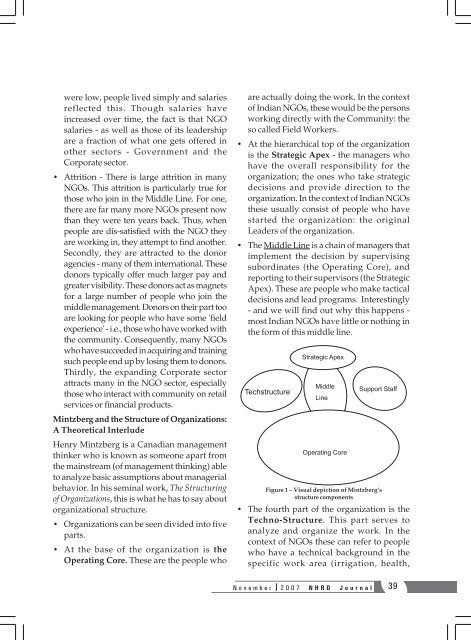NHRD Journal - National HRD Network
NHRD Journal - National HRD Network
NHRD Journal - National HRD Network
You also want an ePaper? Increase the reach of your titles
YUMPU automatically turns print PDFs into web optimized ePapers that Google loves.
were low, people lived simply and salaries<br />
reflected this. Though salaries have<br />
increased over time, the fact is that NGO<br />
salaries - as well as those of its leadership<br />
are a fraction of what one gets offered in<br />
other sectors - Government and the<br />
Corporate sector.<br />
• Attrition - There is large attrition in many<br />
NGOs. This attrition is particularly true for<br />
those who join in the Middle Line. For one,<br />
there are far many more NGOs present now<br />
than they were ten years back. Thus, when<br />
people are dis-satisfied with the NGO they<br />
are working in, they attempt to find another.<br />
Secondly, they are attracted to the donor<br />
agencies - many of them international. These<br />
donors typically offer much larger pay and<br />
greater visibility. These donors act as magnets<br />
for a large number of people who join the<br />
middle management. Donors on their part too<br />
are looking for people who have some 'field<br />
experience' - i.e., those who have worked with<br />
the community. Consequently, many NGOs<br />
who have succeeded in acquiring and training<br />
such people end up by losing them to donors.<br />
Thirdly, the expanding Corporate sector<br />
attracts many in the NGO sector, especially<br />
those who interact with community on retail<br />
services or financial products.<br />
Mintzberg and the Structure of Organizations:<br />
A Theoretical Interlude<br />
Henry Mintzberg is a Canadian management<br />
thinker who is known as someone apart from<br />
the mainstream (of management thinking) able<br />
to analyze basic assumptions about managerial<br />
behavior. In his seminal work, The Structuring<br />
of Organizations, this is what he has to say about<br />
organizational structure.<br />
• Organizations can be seen divided into five<br />
parts.<br />
• At the base of the organization is the<br />
Operating Core. These are the people who<br />
are actually doing the work. In the context<br />
of Indian NGOs, these would be the persons<br />
working directly with the Community: the<br />
so called Field Workers.<br />
• At the hierarchical top of the organization<br />
is the Strategic Apex - the managers who<br />
have the overall responsibility for the<br />
organization; the ones who take strategic<br />
decisions and provide direction to the<br />
organization. In the context of Indian NGOs<br />
these usually consist of people who have<br />
started the organization: the original<br />
Leaders of the organization.<br />
• The Middle Line is a chain of managers that<br />
implement the decision by supervising<br />
subordinates (the Operating Core), and<br />
reporting to their supervisors (the Strategic<br />
Apex). These are people who make tactical<br />
decisions and lead programs. Interestingly<br />
- and we will find out why this happens -<br />
most Indian NGOs have little or nothing in<br />
the form of this middle line.<br />
Figure 1 – Visual depiction of Mintzberg’s<br />
structure components<br />
• The fourth part of the organization is the<br />
Techno-Structure. This part serves to<br />
analyze and organize the work. In the<br />
context of NGOs these can refer to people<br />
who have a technical background in the<br />
specific work area (irrigation, health,<br />
November 2007 <strong>N<strong>HRD</strong></strong> <strong>Journal</strong> 39
















